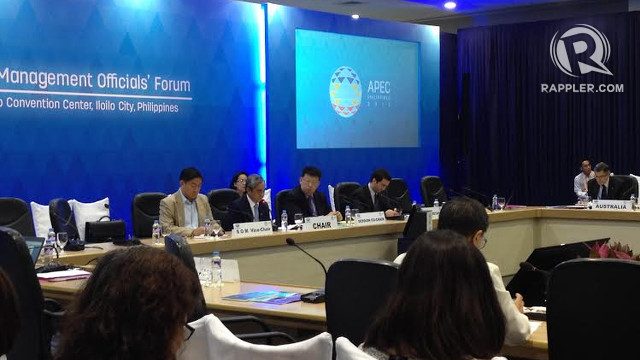SUMMARY
This is AI generated summarization, which may have errors. For context, always refer to the full article.

ILOILO CITY, Philippines – Disaster officials from member-countries of the Asia Pacific Economic Cooperation (APEC) finalized the main body of the APEC Framework on Disaster Risk Reduction on Wednesday, September 23, in Iloilo City.
The final “basic framework” was the fruit of roughly 4 hours of discussion and debate between officials. It is the main outcome of the 9th Senior Disaster Management Officials’ Forum held from September 22 to 23 as part of this year’s APEC meetings.
The discussion was facilitated by the session’s chairperson, the Philippines’ Office of Civil Defense Undersecretary Alexander Pama.
The new APEC framework can now be counted as a “major deliverable in this year’s APEC hosting,” said Presidential Management Staff Undersecretary Ferdinand Cui who also sat at the panel as APEC Senior Officials’ Meeting vice chair.
The Philippines, host of this year’s APEC events, is among the most disaster-vulnerable countries in the world, threatened by typhoons, floods, and earthquakes. It endured the onslaught of Super Typhoon Haiyan, one of the strongest storms in recent history, in 2013.
The roughly 15-paragraph document was only finalized after a paragraph-by-paragraph analysis by the body composed of representatives from APEC countries including Australia, Korea, Japan, United States, Philippines, China, Vietnam, and more.
Debates, compromises
One of the stickiest provisions had to do with whether or not to highlight other international disaster risk reduction frameworks in the APEC document.
China, in particular, did not want the Sendai Framework on Disaster Risk Reduction to be emphasized over and above other frameworks or agreements APEC countries may choose to adopt on their own.
In the end, delegates agreed to mention the Sendai Framework only once and refer to other agreements in a general manner.
Another issue that spurred discussion was the process by which the APEC framework would be endorsed to the heads of state of APEC countries. It was decided that it would be endorsed to the leaders “subject to the consideration of APEC ministers.”
The final document recognizes the risks to disaster shared by APEC countries because of their location in the Pacific Ring of Fire and paths of strong typhoons, and vulnerability to phenomena ligh El Niño and La Niña exacerbated by climate change.
World Bank estimates that APEC countries have incurred over $100 billion in disaster-related economic losses a year for the past 10 years.
Four pillars
The framework also calls on APEC countries to cooperate with one another in disaster risk reduction and management to make their economies and citizens ore resilient to calamities.
It names 4 pillars of disaster risk reduction: Prevention and Mitigation, Preparedness, Response and Rehabilitation, and Build Back Better.
The framework also highlights the essential role of the private sector, through the APEC Business Advisory Council ad local and regional businesses, in disaster preparedness, response, and rehabilitation.
It calls for collaboration between government and private sector, one of the recognized best practices among member-countries.
It concludes by calling for specific actions, including the elevation of the framework to APEC leaders and the conduct of “regular high-level policy dialogues and other higher options for APEC engagements focusing on DRR (disaster risk reduction).”
Cooperation with other like-minded organizations and between countries is encouraged by the framework as well as voluntary commitments from countries or APEC partners.
The framework commits to the development of an action plan “that will serve as the implementation, monitoring and evaluation tool of APEC for the realization of this Framework.” – Rappler.com
Add a comment
How does this make you feel?









There are no comments yet. Add your comment to start the conversation.